If you’ve come to the point in your vaping journey where you’re thinking of building your own coils, knowing the different types of vape wires and how to use them is essential information. Different gauges(diameter) of vape wires will give you different resistances & ramp up times, while different types of vape wires will give you different flavor & cloud production.
Even if you aren’t building your own coils, it can be hazardous to use coils of certain materials in the wrong mode (see Nickel wire down below). Knowing about wire gauge and the types of vape wires is not only a matter of preference, but also a matter of safety.
There are five types of wires that are commonly used for vaping, and they each have differing uses and properties. Some wires can only be used for vaping with wattage, some only with temperature control mode, and one special wire can be used with either. We will discuss each one in detail down below, but first a lesson on wire gauges and resistance.
- Coil wire is available in a variety of gauges, denoted by numbers such as 22, 24, 26, 28, 30, and 32. The number refers to the diameter of the wire, and the higher the number, the thinner the wire, e.g. 32 is thinner than 28.
- Thicker wire, such as 22-gauge, will have a lower resistance than thinner wire. Thicker lower gauge wire takes longer to heat up than thinner higher gauge wire. In vape coil wires, this is known as the “ramp-up time.”
- There are five main types of wire used for vape coils. These are Kanthal, Nichrome, Stainless Steel, Nickel, and Titanium. Kanthal, a ferritic iron, chromium, and aluminum alloy, is the most common wire used for vaping.
- Not all types of wire can be used for both wattage and temperature control modes. Kanthal and nichrome are used for wattage mode, while steel, nickel, and titanium are only suitable for temp control mode.
Wire Gauge and Resistance
When purchasing wire, you’ll find that it comes in various gauges. This is the diameter or “thickness” of the wire. Most commonly, you’ll see 22, 24, 26, 28, 30, and 32 gauge wire used for vaping. As a rule of a thumb, the higher the value of the gauge, the thinner the wire is. As an example, a 28 gauge wire will be thinner than a 26 gauge wire, but thicker than a 30 gauge wire.
In addition, a thicker wire will have a lower resistance while a thinner wire will have a higher resistance. This also affects how quickly the wire heats up. The time it takes for the wire to heat up to appropriate vaping temperatures is called “ramp-up time”. Thicker lower gauge wire takes longer to heat up than thinner higher gauge wire, thus 30 gauge wire has a very fast ramp up time, while 22 gauge wire has a slow ramp time.
Temperature Control Mode (TC)
You’re probably used to using wattage with your device, but some coils function only in temperature control mode. To keep things simple, temperature control mode works by using the TCR or temperature coefficient of resistance of a given wires material. Materials like nickel behave predictably with regards to their resistances at certain temperatures. Your mod uses this information to regulate the current to the coil as it heats up and will reduce the current to the coil if it gets too hot, in order to keep the coil at a safe operating temperature.
Types of Vape Wire
There are five commonly used types of vape wires. These are: kanthal, nichrome, stainless steel, nickel, and titanium.
Kanthal Wire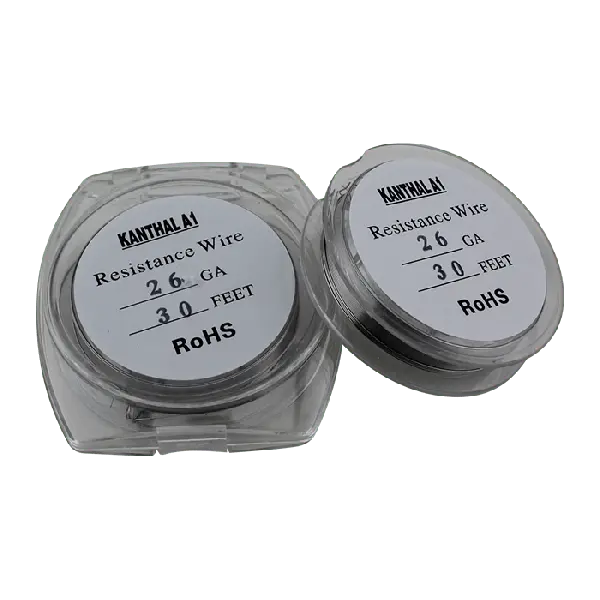
Kanthal is the most common wire used for vaping, and is a ferritic iron, chromium-aluminium alloy. Because of its inexpensive price, wide availability, and resistance to oxidation kanthal is a great material for building coils.
While kanthal may not give you as good of a flavor as some of the other vape wires, it’s extremely easy to work with and will hold its shape well. This is perfect for vaping and makes for a very durable coil material. Kanthal can only be used with wattage mode.
Nichrome Wire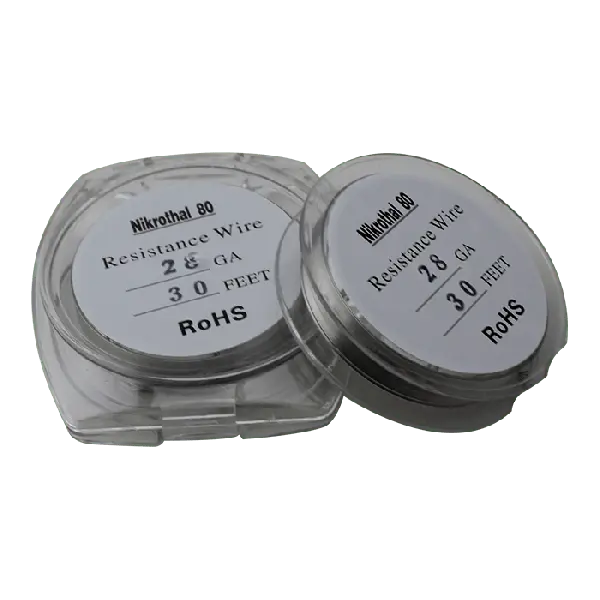
Nichrome wire is another great wire that can be used for vaping, and is a nickel and chromium alloy. While less commonly found in stores than kanthal, nichrome is similarly resistant to oxidation and can function at high temperatures without being damaged.
Nichrome has a much lower melting point than kanthal and can catch fire if you aren’t careful, so you’ll want to pulse nichrome coils slowly to start. Nichrome also heats up faster than Kanthal. Additionally, because nichrome contains nickel, those with a nickel allergy should avoid using it. Nichrome can only be used with wattage mode.
Stainless Steel Wire
Stainless Steel is a special vape wire that can be used with either wattage or temperature control mode, and is a chromium, nickel and carbon alloy. While stainless steel comes in a variety of grades, 316 is medical and food grade and is perfect for vaping.
Stainless steel will heat up very quickly, and has a faster ramp up time than kanthal or nichrome wire. Stainless steel is also very easy to work with and will hold its shape nicely. Like nichrome, stainless steel contains nickel, so those with a nickel allergy should avoid using it. Stainless steel can be used with either wattage or temperature control mode.
Nickel Wire
Nickel wire is also referred to as Ni200, and is made of pure nickel. Nickel heats up the fastest out of all vape wires and was the first wire used with temperature control mode. Because of its soft and springy nature, nickel wire is harder to work with than kanthal or nichrome.
While nickel wire can offer better flavor and a faster ramp up time than some other vape wires (such as kanthal), it should only ever be used in temperature control mode. If nickel wire gets too hot and overheats, and you can end up with nickel or even graphite in your lungs. Never use nickel with wattage mode, only with temperature control mode. Those with a nickel allergy should obviously avoid using Ni200 wire.
Titanium Wire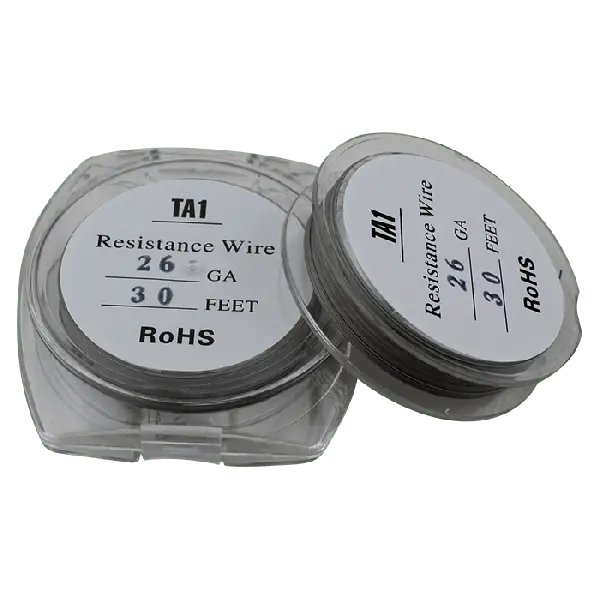
The last vape wire on our list is Titanium, and is another great material for use with temperature control mode. Titanium wire is composed of pure titanium, and can be quite difficult to find and purchase in stores.
Titanium wire is said to produce a much crisper and cleaner flavor than kanthal or nichrome, but there are some safety precautions to be had when using it. Firstly, titanium wire can release a toxic gas (titanium dioxide) if heated above 650C, and so it should only be used in temperature control mode. If you have a properly functioning TC mod, you won’t have a problem using Titanium.
Secondly, if titanium catches fire it can be nearly impossible to put it out. Again, just make sure to never use wattage mode with titanium vape wire and you’ll be fine.

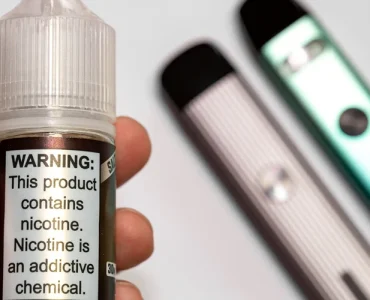
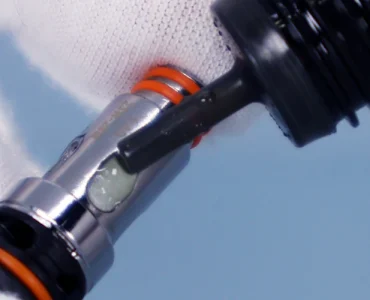



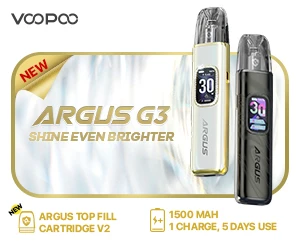
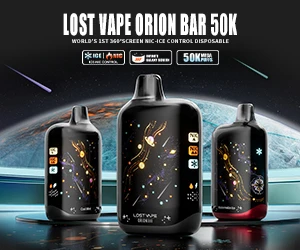


Super helpful! Awesome post!
Perfect piece of info, thank you very much